Japan's top three major Edo period Hirayama-jiro (hilltop and adjoining flatland layout) styled castles were Himeji Castle, Iyo Matsuyama Castle, and Tsuyama Castle in Tsuyama city, Okayama Prefecture.
Tsuyama Castle once consisted of 77 primary defensive structures, including the main keep, various yagura (watch-tower turrets), gates, and the palaces and living quarters around the terraced mountain. Hiroshima Castle by comparison had 76 structures, and current World Heritage listed Himeji Castle had just 61.
A castle was first constructed on the hilltop in 1441, but abandoned a few years later. The current large scale construction dates from 1603, and was built by Mori Tadamasa. It took 13 years to complete the entire castle, ending in 1616. The castle was the administrative base of the Tsuyama Han daimyo, the Mori clan from 1603 until the Mori clan died out in 1697. The Tokugawa related Matsudaira clan took control from 1698 to well after the fall of the Tokugawa clan and feudalism in 1868, with the Matsudaira remaining in the castle until 1871. When this castle was built, Japan's castle-building technology was at its peak, and Tsuyama Castle's ingenious layout was outstanding in both offence and defence, making it a typical example of a modern hill and flatland castle.
Tsuyama was built overlooking the confluence of the Yoshii and Miya Rivers. The low mountain top was shaved flat to form the main citadel, and the Ninomaru and Sannomaru enclosures were arranged in split levels, banked with high stone walls surrounding the main Honmaru to the south and the rear bailey to the north. The south, west, and north sides of the lower Sannomaru form the main enclosure, which is surrounded by earthworks and moats. The castle’s eastern side is a steep cliff, and the Miyagawa River flowing north and south directly below it served as a natural line of defense.
The routes leading to the main honmaru are repeatedly blocked with box-shaped masugata koguchi gate systems and are designed with great consideration for defence.
There were 60 turrets throughout the castle. This is a large number compared to other early modern castles throughout the country, such as Nagoya that had just ten, and the grounds were packed with sturdy structures, such as the Omote-nakamon, the main gate leading from the San-no-maru to the Ni-no-maru. This yaguramon gatehouse, with the first floor being the castle gate and the second floor being the turret, was the largest gate in Tsuyama Castle. The upper turret section was about 32 meters long, comparable in size to the great gates of Edo and Osaka Castles.
The Bitchu Yagura, a turret originally part of the lord's palace, was authentically restored in 2005 as part of the castle's 400th anniversary. The Bitchu Yagura is located at the southwest end of the Honmaru Palace, and its name is said to come from Ikeda Bitchu no Kami Nagayuki, the lord of Tottori Castle. The Morike Sendai Jitsuroku, historical document from the Mori Domain era, states that the "Bitchu Yagura was built when Ikeda Bitchu no Kami Nagayuki entered the castle." Lord Mori Tadamasa was married to Omatsu, the eldest daughter of Ikeda Bitchu no Kami Nagayuki. It is believed that the Bitchu Yagura was completed when Nagayuki visited Tsuyama Castle. The fact that tiles bearing the Ikeda family's swallowtail butterfly crest were unearthed during an excavation of the Bitchu Yagura site also indicates that the building had a deep connection to the Ikeda family.
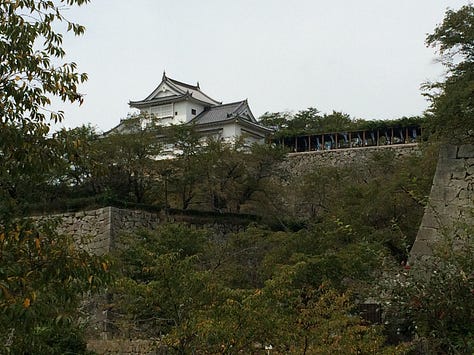
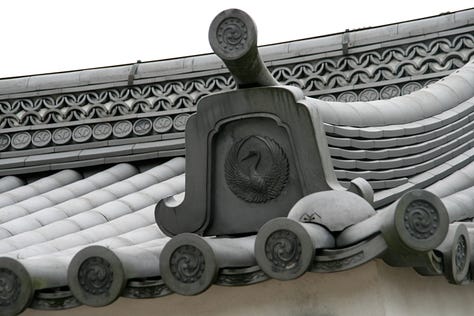
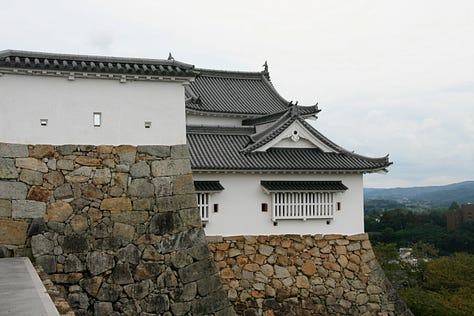
Like the rest of Tsuyama Castle, the exterior of the Bitchu Yagura is finished in white plaster like the other turrets, but the Honmaru Palace plan shows the Bitchu Yagura together with the Nagatsukasa and Torai Yaguras connected to it, indicating that these buildings were recognized as part of the palace. These architectural drawings show that the interior was floored with tatami matting, equipped with an audience chamber and a tea room, and that fine karakami papers were used for the fittings, showing that the interior was of palace styled architecture, yet had a delicate, feminine finish. For this reason, given its location at the very back of the Honmaru Palace, it is thought to have been used as part of the living space for a woman such as Omatsu, or a concubine of the castle lord. As the largest of Tsuyama Castle's 60 turrets and located on a stone wall jutting out from the south side of the honmaru, the Bitchu Yagura was the second most important turret after the castle tower keep, and was a highly symbolic building. There are very few examples of turrets with such a unique structure and use, and as it was distinctive among Tsuyama Castle's buildings, it became the subject of restoration.
Lords of Tsuyama - Mori Clan
The first lord of Tsuyama, Mori Tadamasa, was the sixth son of Mori Kanenari, lord of Kanayama Castle in Mino Province (Gifu Pref.). In 1603, in recognition of his military service to the Tokugawa family, he was promoted from daimyo of Nakajima on the Shinano River with a fief of 137,500 koku, to being daimyo of the whole of Mimasaka Province with a fief of 186,500 koku. Tadamasa was the youngest brother of the famed Mori Ranmaru, who met a heroic death alongside his lord, Oda Nobunaga, in the Honnoji Incident of 1582. The Mori clan ruled Mimasaka Province for 95 years over four generations, but the fourth castle lord, Mori Naganari, died without an heir, and the Tsuyama Mori clan became extinct. Later, Mori Naganao, the son of the second feudal lord, Nagatsugu, restored the Mori main clan as lord of Nishiebara Domain in Bitchu, and then was transferred to Ako in Harima in 1706.
Matsudaira Clan
Matsudaira Nobutomi, who replaced the Mori family as the new lord of Tsuyama Domain with a fief of 100,000 koku, was the great-grandson of Tokugawa Ieyasu's second son, Yuki (Matsudaira) Hideyasu, and was known as the Matsudaira Echizen clan, and held important positions within the Tokugawa administration. Nine generations ruled for 174 years until the domain was abolished in 1871.
Tower Keep and Structures
Also known as Kakuzan Castle, Tsuyama Castle's 23 meter high tower keep had wide flared stone dropping chutes on each corner of the first floor and gun slits and arrow slits on each floor up to the fourth floor. The uppermost floor’s exterior was covered with wood panelling according to a remaining photograph. The fourth floor is roughly the same size as the top floor, and once had a balustrade around the outer veranda. The narrow roof of the fourth floor was made of boards instead of tiling, and the eaves were shallow. The keep consisted of five stories, although it was unofficially registered as four, as a ban was placed on having towers over five stories high. Lord Mori Tadamasa, refused to dismantle the tower as the laws changed, and instead, simply removed the roofing supports and tiles from between the fourth and and fifth floors, claiming it was not a roof, but eaves. The officials were finally convinced (possibly with a little financial incentive), and the keep was registered as being “Four stories, with eaves giving the impression of an extra floor".
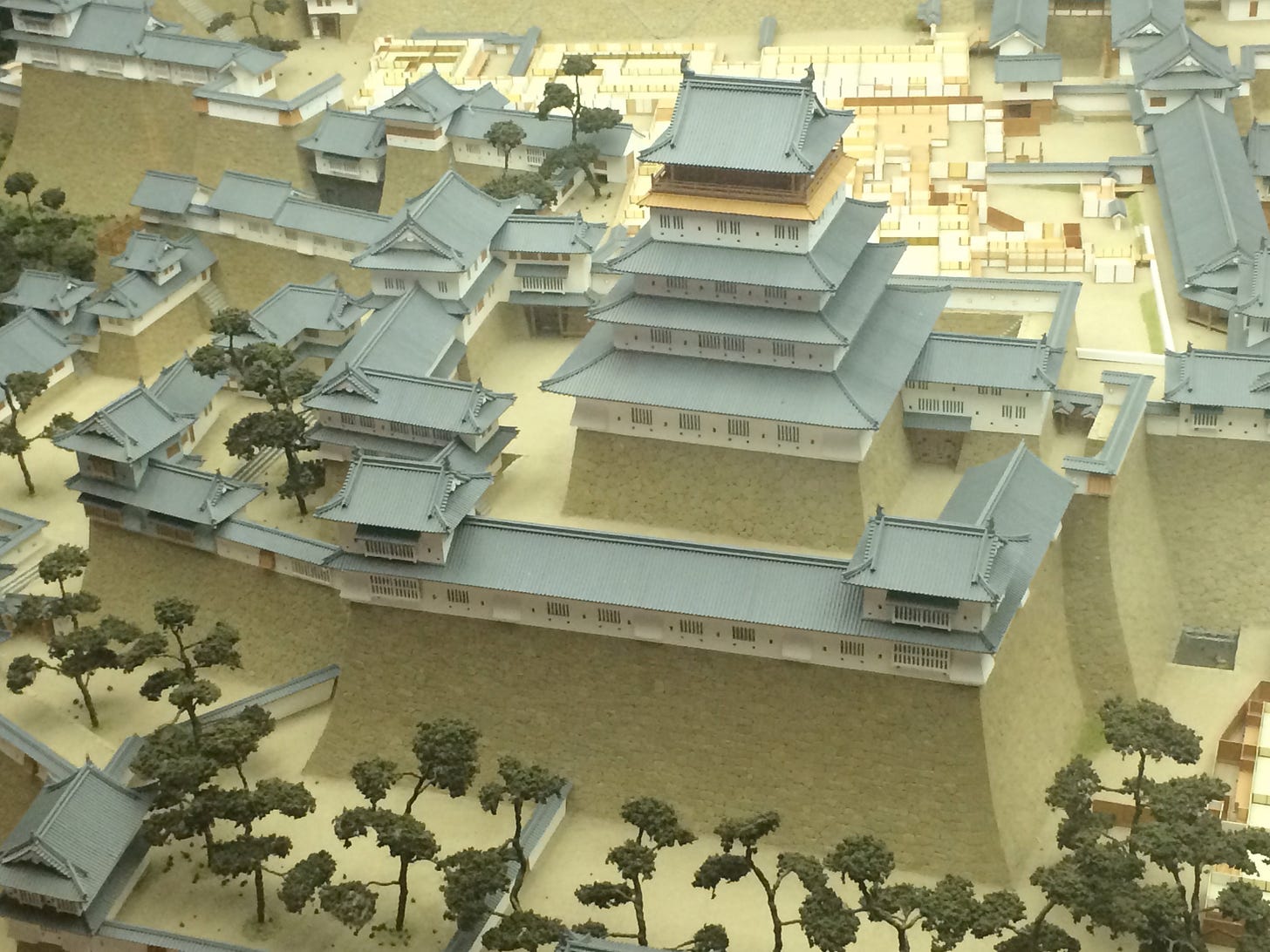
It was a practical, modern sotogata tower keep, a type developed by Todo Takatora where the tower base is a precise square, with the upper floors getting smaller. It was bereft of ornamentation such as the karahafu or chidorihafu triangular and undulating roofing features seen on other castle keeps. Tamon yagura, long corridor-like turrets surrounded the southwest, west, and northwest sides of the castle tower around the Honmaru.
One famous story tells of how Tsuyama’s Lord Mori Tadamasa dispatched his vassal, Yabuta Suketayu, together with a carpenter and an artist as spies to observe and sketch Kokura Castle’s impressive main keep in order to make something similar at Tsuyama. The spies used a boat to view the seaside castle, but their presence was deemed suspicious and they were captured and brought before Lord Hosokawa Tadaoki. Upon hearing their story, kindly Lord Hosokawa is said to have allowed them to inspect the interior of Kokura’s fine keep, and even supplied them with a copy of the architectural design charts. Mori Tadamasa is said to have used these instructions to construct Tsuyama’s large keep. Lord Hosokawa Tadaoki later sent a large bell as a gift to Mori Tadamasa on completion of Tsuyama’s tower, which remained in the keep’s top floor until the castle and keep were demolished.
Another interesting feature of the original Tsuyama Castle was the Irozuki or the Coloured Tower. The entire Tsuyama Castle was covered in a thick, white lime based plaster known as shikkui. As can be seen in the restored model, the Irozuki Tower has an unusual look with light blue coloured walls. Why only this turret was painted blue, and how the blue pigment was created remains a mystery.
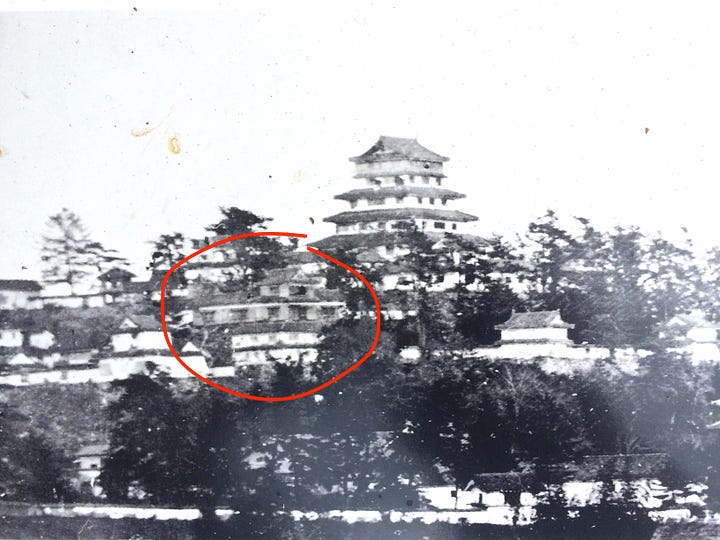
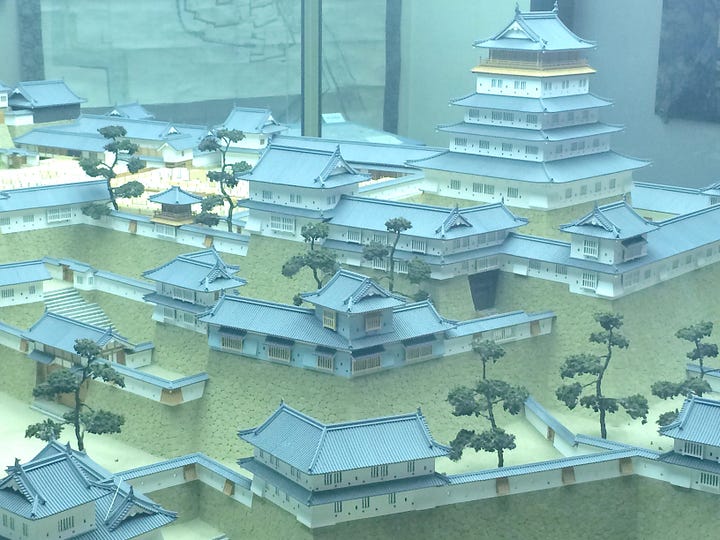
Above, the Irozuki yagura, circled, is noticeably darker than the surrounding white yagura. The model also shows the yagura as a light blue colour
In 1809, the 70-room Honmaru Palace was destroyed in a fire and was not rebuilt. The castle was abandoned in 1871 when the feudal system was abolished, and sold 2 years later. Between 1874 and 1875, the keep, walls, gates and all turrets were dismantled and destroyed. It was not until 1890, when part of the north-western stone walls collapsed following the destruction of the buildings, that conservation efforts began. Unfortunately, this came too late to preserve any of the original buildings. In 1963, Tsuyama Castle’s ruins were registered as a National Historical Site. One gate that did survive was relocated to the nearby Nakayama Shrine. This Yotsuashimon Gate was originally located at the entrance to the Ninomaru. After the castle was abandoned, the gate was relocated in 1874 as the shrine gate of Nakayama Shrine. It was a decorative Yakui styled gate without doors, and the roof has since changed from tiles to cypress bark, but it is one of the few structures from Tsuyama Castle that can still be seen today.
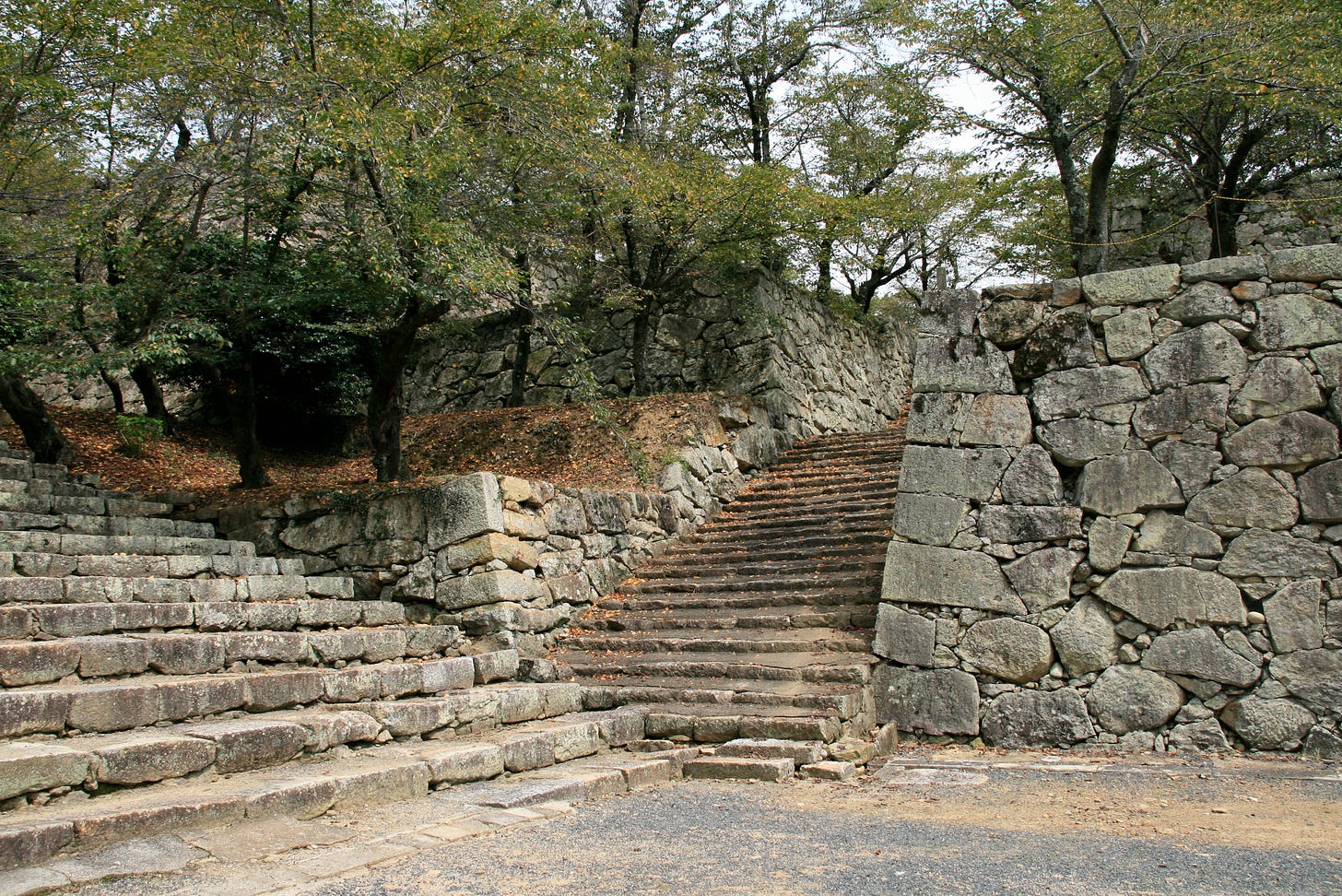
Today, Tsuyama Castle remains in ruins, but what spectacular ruins they are! Surrounded by over 5,000 cherry trees, the grounds and well constructed, impressive stone walls are open to the public and provide a glimpse into the magnificence that was one of Japan's top hirayama castles, Tsuyama Castle.

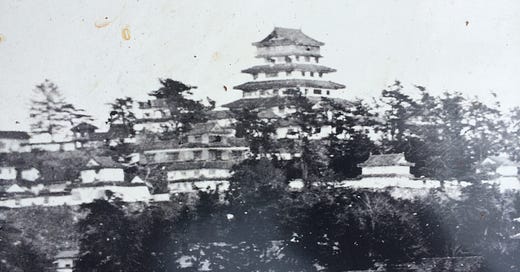



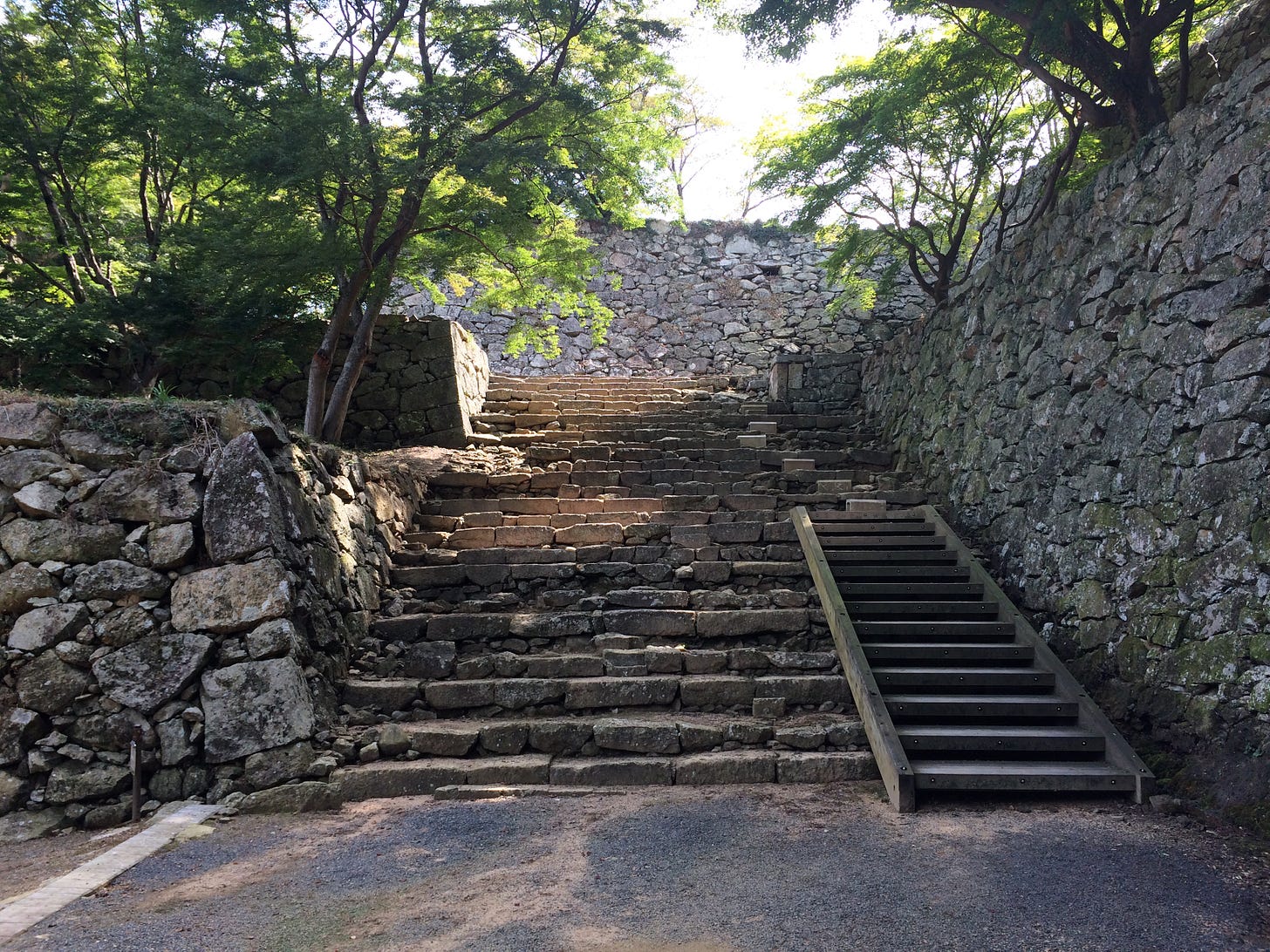
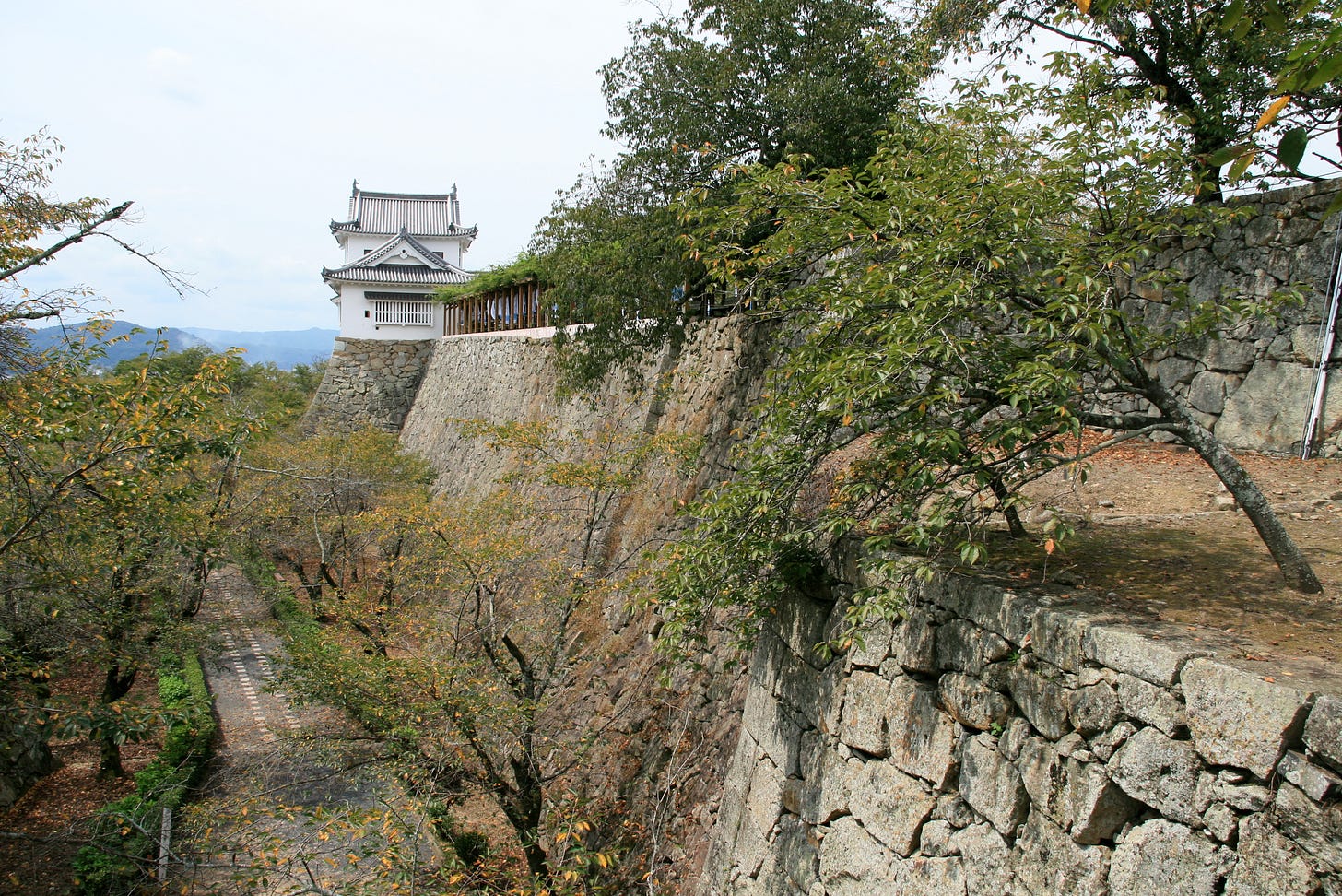
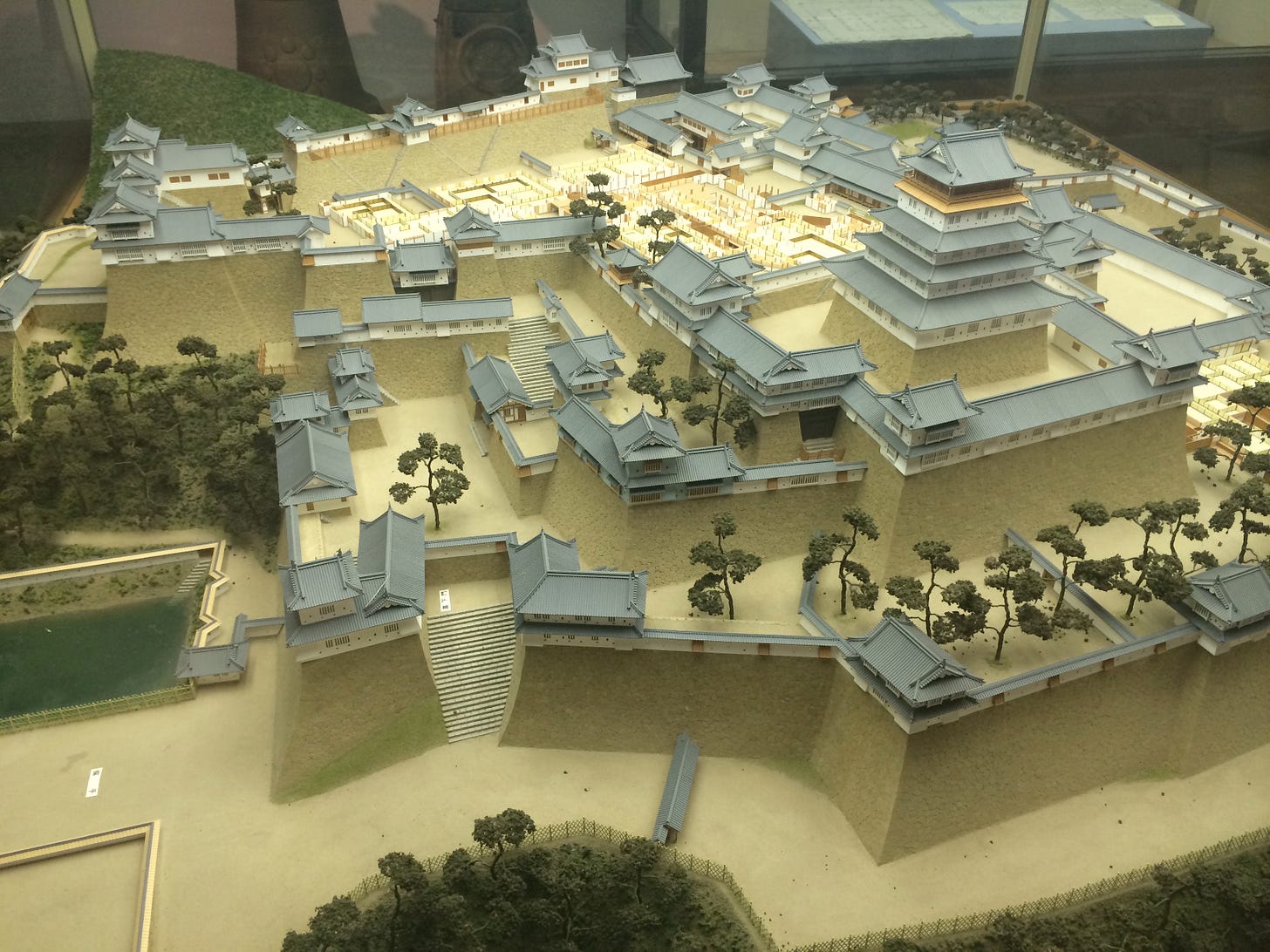
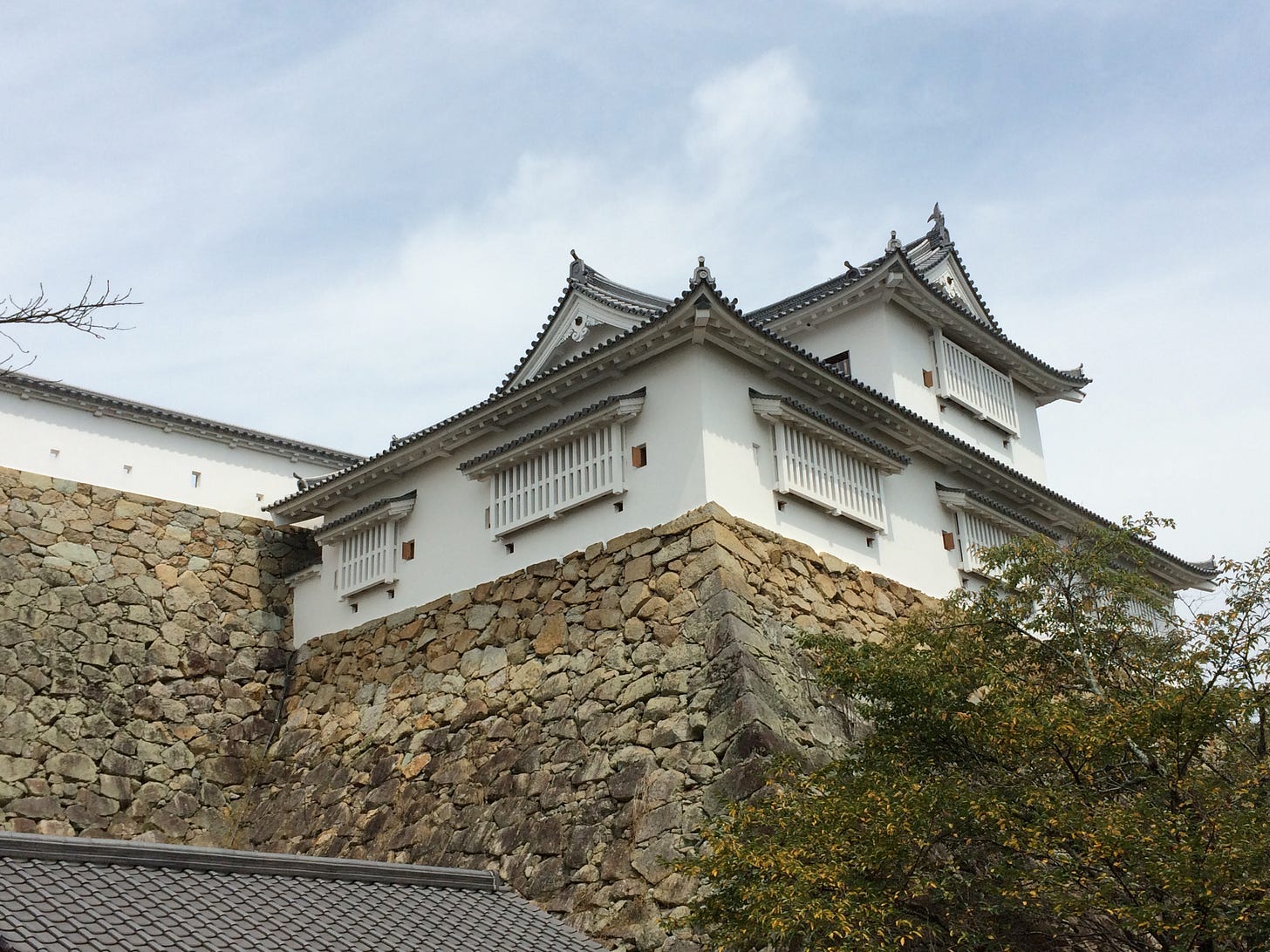
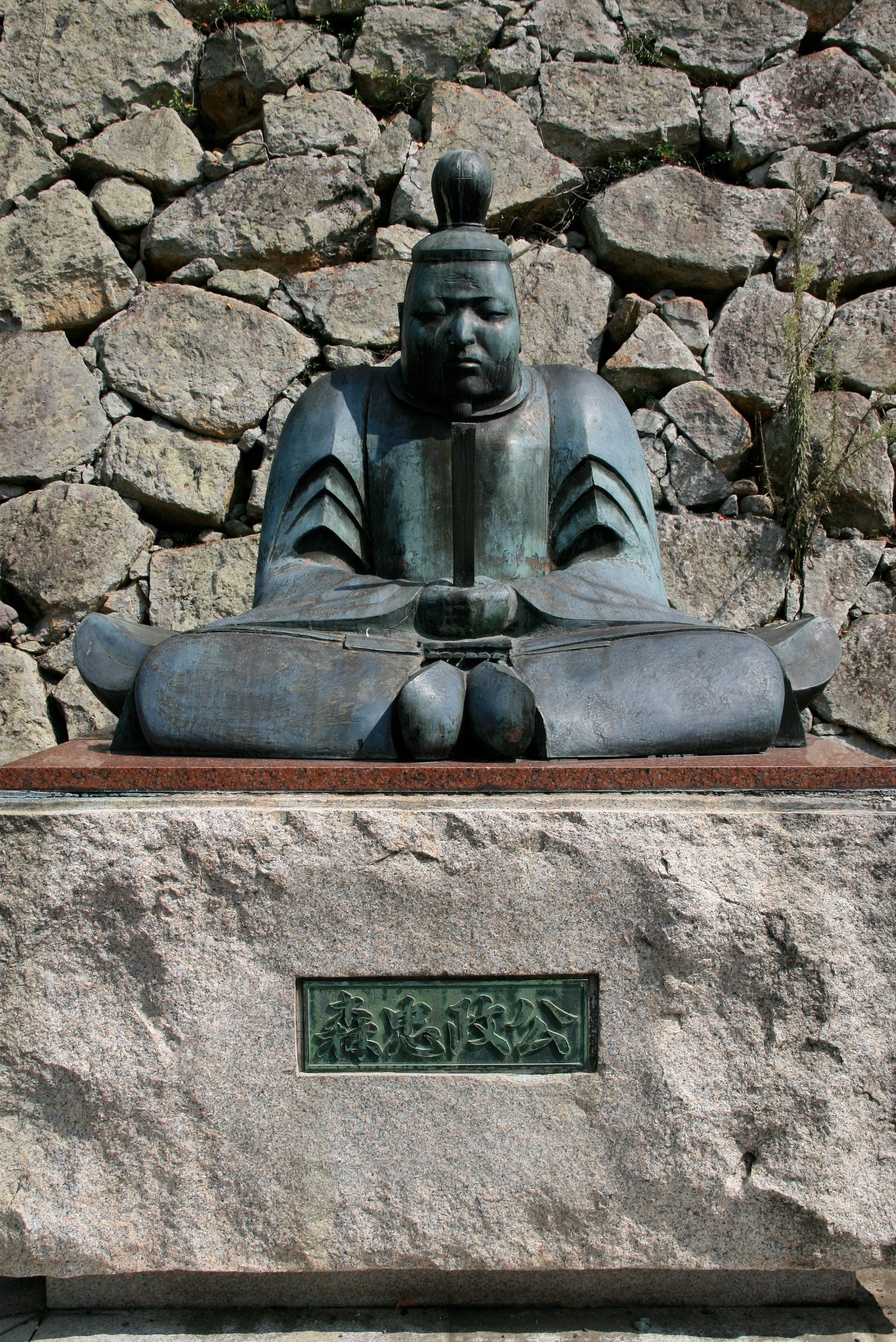
You continue to write such excellent essays here - I always feel like I've embarked on a tour of a lost world.